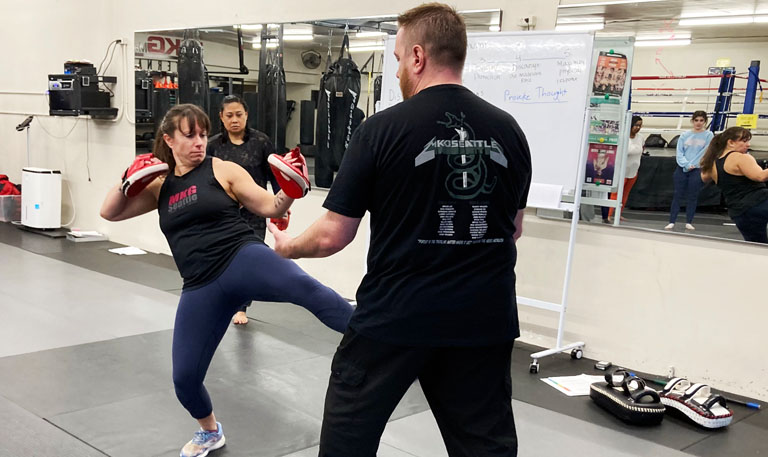It May be More Important Than Ever to Learn Skills of Self-Defense as We Age
BY CONNIE MCDOUGALL
At 6 feet 2 inches and 250 pounds, wearing full-body protection, Alan Moe makes a formidable assailant. So it feels pretty liberating that, at 73, I’m slamming an elbow into his helmeted face then sending a swift kick to his padded groin. It’s an excellent way to practice self-defense skills without worrying about hurting him. Too much. “I can take the hits but sometimes I get my bell rung,” he laughs. “It’s an honor to give people the experience of using full force.” And it’s especially important to know skills of self-defense as we age.
He role-played the bad guy at a one-day class led by instructor Andy Wilson, 52, owner of the martial arts school, MKG Seattle, where self-defense students learned the five A’s of personal safety: Attitude, awareness, avoidance, assessment and action.
“Being prepared mentally is half the battle,” Wilson says. “Having the right attitude includes how you carry yourself—shoulders back, eyes up, confident with a good stride. You don’t look like a victim.” Awareness also means to trust your instincts. “If you’re uncomfortable, don’t ignore it. Pay attention to those feelings.” Be alert to inadvertent signals, he says. Flashing expensive tech draws unwanted attention. “If an attacker sees something valuable, including jewelry or a watch, that’s a target. Keep any signs of wealth out of sight,” he advises.
Situational awareness is essential, yet people walk around with their heads down, fiddling with a smartphone. “Not only is that a distraction but it takes away the very senses you need,” Wilson explains. “That goes for earbuds and headphones, too.” Being alert allows for another skill—avoidance. “Your best option is always to avoid a problem if you can. Cross the street. Go into a store. Run away. There’s a phrase in self-defense: Distance equals time equals options.”
If it comes time to do something, a quick assessment is in order, Wilson says. Look for a way out. Are there people nearby? Is there a car, a door, anything that can be used as a barrier? Escape is always the first priority. Then, depending on the threat level, taking action follows a force continuum, which starts at one, do nothing, ramping up to five, maximum force. Level one isn’t passivity. “If someone has a gun to your head and wants your purse, give it to him,” says Wilson, “and be a good witness to give police information.” Sometimes it’s best to be verbally assertive. “Take a step back and give clear commands,” he says. “That can be calls to stop or back off. But if he keeps coming and gets in your face or grabs you, defend yourself.”
That means total commitment. “At level five we say, go nuts and go home,” Wilson says. Aim for the most vulnerable parts—eyes, throat, groin, knees and feet. He offers this pointed prompt: balls and eyeballs. “One of those will always be open. If he’s protecting his groin, his eyes are vulnerable. If his hands are over his eyes, his groin is vulnerable.” It’s not a matter of inflicting pain, he notes. “People high on drugs may not feel pain. It’s about getting a reaction. A thumb in the eye or a hit to the throat; everyone reacts to that. And then you escape.” If something isn’t working, try something else, like stomping on the top of a foot. “We don’t advocate punching, though,” says Wilson. “Effective punching depends on ability and mass.” The idea is not to defeat an assailant or knock him out. It’s to discourage and end an attack, then escape.
Weapons are a personal choice, Andy says, but if you’re going to carry something, including pepper spray, know how to use it under stress. “And remember, a weapon can be taken away and used on you.”
In his self-defense classes, ages range from teens to people in their 80s, but the strategies are the same for everyone. “I tell people, do everything to the best of your ability and modify according to those abilities,” Wilson says. “In class, you get a good sense of your strengths and weaknesses. Most important, it promotes thought.”
Taking the class was freeing for 58-year-old Mary O’Brien, especially being told to shout “No!” when delivering a kick or chop. “Nice girls don’t yell,” she laughs. But even more, as a nurse who must walk to and from her car in downtown Seattle, and as a woman who experienced sexual assault in the past, she found empowerment. “I feel a greater confidence to respond by setting boundaries to protect myself, my community, and even for the perpetrator’s own good,” she says, “because wounded people don’t get a license to wound others.”
Connie McDougall is a former news reporter, and current freelance writer of nonfiction and personal essays. A lifelong student and proud English major, she has pursued lessons in flying, scuba diving, tai chi, Spanish, meditation, hiking, and Zumba.


